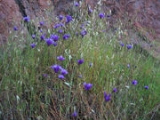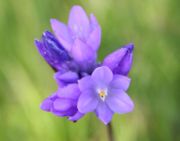
Dichelostemma
Encyclopedia

Flowering plant
The flowering plants , also known as Angiospermae or Magnoliophyta, are the most diverse group of land plants. Angiosperms are seed-producing plants like the gymnosperms and can be distinguished from the gymnosperms by a series of synapomorphies...
s in the order Asparagales
Asparagales
Asparagales is the name of an order of plants, used in modern classification systems such as the APG III system . The order takes its name from the family Asparagaceae and is placed in the monocots. The order has only recently been recognized in classification systems...
. The genus is native to the western United States
United States
The United States of America is a federal constitutional republic comprising fifty states and a federal district...
, especially in northern California
California
California is a state located on the West Coast of the United States. It is by far the most populous U.S. state, and the third-largest by land area...
, but also east to Utah
Utah
Utah is a state in the Western United States. It was the 45th state to join the Union, on January 4, 1896. Approximately 80% of Utah's 2,763,885 people live along the Wasatch Front, centering on Salt Lake City. This leaves vast expanses of the state nearly uninhabited, making the population the...
and north to Oregon
Oregon
Oregon is a state in the Pacific Northwest region of the United States. It is located on the Pacific coast, with Washington to the north, California to the south, Nevada on the southeast and Idaho to the east. The Columbia and Snake rivers delineate much of Oregon's northern and eastern...
and southern Washington.
The genus is placed in family Asparagaceae
Asparagaceae
Asparagaceae is the botanical name of a family of flowering plants, placed in the order Asparagales of the monocots.In earlier classification systems, the species involved were often treated as belonging to the family Liliaceae...
, subfamily Brodiaeoideae, in the latest Angiosperm Phylogeny Group
Angiosperm Phylogeny Group
The Angiosperm Phylogeny Group, or APG, refers to an informal international group of systematic botanists who came together to try to establish a consensus on the taxonomy of flowering plants that would reflect new knowledge about plant relationships discovered through phylogenetic studies., three...
classification (2009
APG III system
The APG III system of flowering plant classification is the third version of a modern, mostly molecular-based, system of plant taxonomy...
). The family used has varied considerably over time. Older sources may still place it in the in the family Liliaceae
Liliaceae
The Liliaceae, or the lily family, is a family of monocotyledons in the order Liliales. Plants in this family have linear leaves, mostly with parallel veins but with several having net venation , and flower arranged in threes. Several have bulbs, while others have rhizomes...
, in the order Liliales
Liliales
Liliales is an order of monocotyledonous flowering plants. This order of necessity includes the family Liliaceae, but both the family and the order have had a widely disputed history, with the circumscription varying greatly from one taxonomist to another...
; earlier versions of the APG classifications used the family Themidaceae
Themidaceae
Brodiaeoideae is a monocot subfamily of flowering plants in the family Asparagaceae, order Asparagales. It has been treated as a separate family, Themidaceae. They are native to Central America and western North America, from British Columbia to Guatemala...
.
These plants grow from perennial
Perennial plant
A perennial plant or simply perennial is a plant that lives for more than two years. The term is often used to differentiate a plant from shorter lived annuals and biennials. The term is sometimes misused by commercial gardeners or horticulturalists to describe only herbaceous perennials...
corm
Corm
A corm is a short, vertical, swollen underground plant stem that serves as a storage organ used by some plants to survive winter or other adverse conditions such as summer drought and heat ....
s that produce a raceme
Raceme
A raceme is a type of inflorescence that is unbranched and indeterminate and bears pedicellate flowers — flowers having short floral stalks called pedicels — along the axis. In botany, axis means a shoot, in this case one bearing the flowers. In a raceme, the oldest flowers are borne...
or umbel
Umbel
An umbel is an inflorescence which consists of a number of short flower stalks which are equal in length and spread from a common point, somewhat like umbrella ribs....
-like inflorescence
Inflorescence
An inflorescence is a group or cluster of flowers arranged on a stem that is composed of a main branch or a complicated arrangement of branches. Strictly, it is the part of the shoot of seed plants where flowers are formed and which is accordingly modified...
. The flowers are bell- or tube-shaped and produce capsules with black seeds. The name, from the Greek
Greek language
Greek is an independent branch of the Indo-European family of languages. Native to the southern Balkans, it has the longest documented history of any Indo-European language, spanning 34 centuries of written records. Its writing system has been the Greek alphabet for the majority of its history;...
for "toothed crown", refers to the stamen
Stamen
The stamen is the pollen producing reproductive organ of a flower...
appendages.
Dichelostemma was once included as part of the genus
Genus
In biology, a genus is a low-level taxonomic rank used in the biological classification of living and fossil organisms, which is an example of definition by genus and differentia...
Brodiaea
Brodiaea
Brodiaea is a monocot genus of flowering plants in the family Asparagaceae, subfamily Brodiaeoideae, also known by the common name cluster-lilies...
.
Species
- Dichelostemma capitatumDichelostemma capitatumDichelostemma capitatum , called Blue dicks, Purplehead and Brodiaea occur in Arizona, California, Oregon, Utah, New Mexico, and northern Mexico.-Subspecies:...
(syn. D. pulchellum) – Blue Dicks- Dichelostemma capitatum subsp. capitatum
- Dichelostemma capitatum subsp. pauciflorum
- Dichelostemma congestumDichelostemma congestumDichelostemma congestum is a species of flowering plant known by the common name ookow or fork-toothed ookow. This perennial wildflower is native to the hills and mountains of western North America...
- Ookow - Dichelostemma ida-maiaDichelostemma ida-maiaDichelostemma ida-maia is a species of flowering plant known as firecracker flower. It is native to northern California and southern Oregon, where it grows in mountain forests, woodlands, and coastal meadows...
- Firecracker flower - Dichelostemma multiflorumDichelostemma multiflorumDichelostemma congestum is a species of flowering plant known by the common names roundtooth snakelily, manyflower brodiaea and wild hyacinth. It is native to California and Oregon, where it grows in hills, mountains, and inland grasslands...
- Dichelostemma volubileDichelostemma volubileDichelostemma volubile is a species of flowering plant known by the common names twining snakelily and twining brodiaea. This wildflower is endemic to the mountain foothills of California, where it grows in scrub and woodland....
Cultivars
- Dichelostemma 'Pink Diamond' - probably D. ida-maia × D. congestum (sometimes called Dichelostemma congestum).

